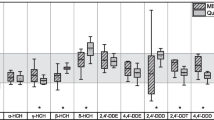Abstract
With the extensive application of task-specific ionic liquids (TSILs), their environmental impact has attracted increasing attention. However, no studies involving residue analyses of TSILs have been reported in the literature thus far. In the present study, residues of four TSILs ([C2NH2MIm]BF4, [HOEMIm]BF4, [HOEMIm]NO3, [MOEMIm]BF4) were analyzed by high-performance liquid chromatography–tandem mass spectrometry. The limit of detection of instrument was approximately 10−15 g. Residual TSILs were extracted from soil and plant samples by the accelerated solvent extraction method. In water, soil and plants, the coefficient of variation was 0.38%–4.43%, and the method detection limits of the four TSILs were lower than 1.40 ng g−1. These results meet the standards of residue analysis. The present study can provide an analysis method for studying TSIL residues and toxicity in the environment.



Similar content being viewed by others
References
Andrew J, Masetlwa J, Tesfaye T, Sithole B (2020) Beneficiation of eucalyptus tree barks in the context of an integrated biorefinery – optimisation of accelerated solvent extraction (ASE) of polyphenolic compounds using response surface methodology. Sustain Chem Pharm 18:100327
Bhattacharyya S, Shah FU (2018) Thermal stability of choline based amino acid ionic liquids. J Mol Liq 266:597–602
Bystrzanowska M, Pena-Pereira F, Marcinkowski L, Tobiszewski M (2019) How green are ionic liquids? – A multicriteria decision analysis approach. Ecotoxicol Environ Saf 174:455–458
Chen ZL, Feng YY, Wang JL, Wang J, Guan W, Zhang HJ (2014) Effects of [C2mim]OAc (1-ethyl-3-methyl-imidazolium acetate) on the growth of wheat seedlings under Cd2+ stress. Bull Environ Contam Toxicol 92(6):714–718
Das S, Voskian S, Rajczykowski KP, Hatton TA, Bazant MZ (2021) Enabling a stable high-power lithium-bromine flow battery using task-specific ionic liquids. J Electrochem Soc 168(7):070542
Jing CQ, Mu LM, Ren TF, Li BN, Chen SJ, Nan WB (2014) Effect of 1-octyl-3-methylimidazolium chloride on cell replication and membrane permeability of Escherichia coli DH5 alpha. Bull Environ Contam Toxicol 93(1):60–63
Krishnan A, Gopinath KP, Vo DVN, Malolan R, Nagarajan VM, Arun J (2020) Ionic liquids, deep eutectic solvents and liquid polymers as green solvents in carbon capture technologies: a review. Environ Chem Lett 18(6):2031–2054
Li LL, Wu M, Feng YY, Zhao FQ, Zeng BZ (2016) Doping of three-dimensional porous carbon nanotube-graphene-ionic liquid composite into polyaniline for the headspace solid-phase microextraction and gas chromatography determination of alcohols. Anal Chim Acta 948:48–54
Li WX, Zhu L, Du ZK, Li B, Wang JH, Wang J, Zhang C, Zhu LS (2020) Acute toxicity, oxidative stress and DNA damage of three task-specific ionic liquids ([C2NH2MIm]BF4, [MOEMIm]BF4, and [HOEMIm]BF4) to zebrafish (Danio rerio). Chemosphere 249:126119
Mrozik W, Kotlowska A, Kamysz W, Stepnowski P (2012) Sorption of ionic liquids onto soils: experimental and chernometric studies. Chemosphere 88(10):1202–1207
Platzer S, Leyma R, Wolske S, Kandioller W, Heid E, Schröder C, Schagerl M, Krachler R, Jirsa F, Keppler BK (2017) Thioglycolate-based task-specific ionic liquids: metal extraction abilities vs acute algal toxicity. J Hazard Mater 340:113–119
Qu YS, Huang CP, Song YL, Zhang J, Chen BH (2012) Efficient dehydration of glucose to 5-hydroxymethylfurfural catalyzed by the ionic liquid,1-hydroxyethyl-3-methylimidazolium tetrafluoroborate. Bioresour Technol 121:462–466
Rutz C, Schmolke L, Gvilava V, Janiak C (2017) Anion analysis of ionic liquids and ionic liquid purity assessment by ion chromatography. Z Anorg Allg Chem 643(1):130–135
Rykowska I, Ziemblinska J, Nowak I (2018) Modern approaches in dispersive liquid–liquid microextraction (DLLME) based on ionic liquids: a review. J Mol Liq 259:319–339
Shao YT, Du ZK, Zhang C, Zhu LS, Wang JH, Wang J (2017) Acute toxicity of imidazole nitrate ionic liquids with varying chain lengths to earthworms (Eisenia foetida). Bull Environ Contam Toxicol 99(2):213–217
Suleman H, Maulud AS, Shah SN, Man Z, Mutalib MIA (2018) Thermodynamic modelling of liquid–liquid extraction systems involving ionic liquids: a new approach. J Mol Liq 252:18–23
Wu XF, Zhou YH (2009) Environmental Monitoring-Technical guideline on drawing and revising analytical method standards (HJ168-2010). Beijing, China
Xu HT, Zhang CH, Chen G, Shen RP, Ying AG (2016) Application of task-specific ionic liquids to organic synthesis. Chin J Org Chem 36(10):2353–2367
Zhao Y, Wang JY, Jiang HC, Hu YQ (2014) Study on the thermodynamic properties of ether-functionalized imidazolium-based ionic liquids. J Mol Liq 196:314–318
Zhou TT, Wang JH, Zhang C, Zhang J, Zhu LS, Du ZK, Wang J (2017) Determination of residual concentration of ionic liquids with different anions and alkyl-chain lengths in water and soil samples. Anal Chem 89(19):10520–10528
Acknowledgements
This work was supported by the National Natural Science Foundation of China [Grant Numbers 42077042 and 41771282].
Author information
Authors and Affiliations
Corresponding author
Additional information
Publisher's Note
Springer Nature remains neutral with regard to jurisdictional claims in published maps and institutional affiliations.
Supplementary Information
Below is the link to the electronic supplementary material.
Rights and permissions
About this article
Cite this article
Lu, C., Sun, S., Li, H. et al. New Residue Analysis Method for Four Task-Specific Ionic Liquids in Water, Soil and Plants. Bull Environ Contam Toxicol 109, 338–343 (2022). https://doi.org/10.1007/s00128-022-03464-z
Received:
Accepted:
Published:
Issue Date:
DOI: https://doi.org/10.1007/s00128-022-03464-z




